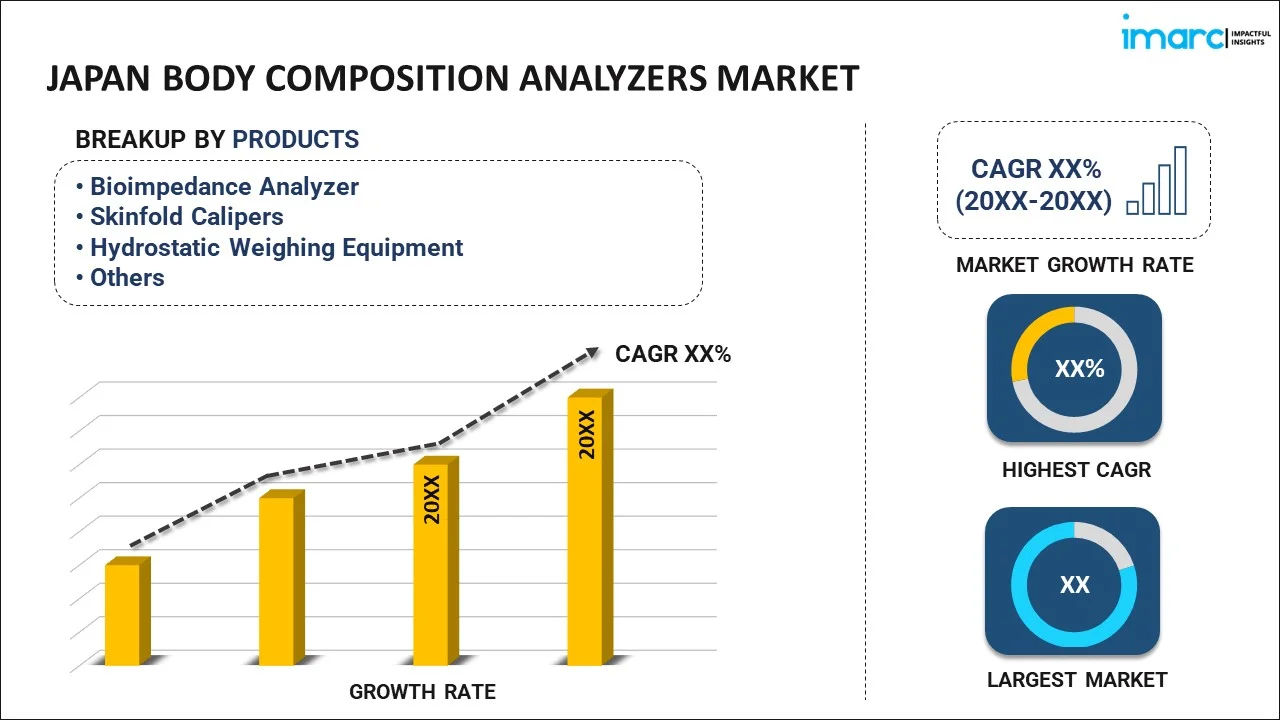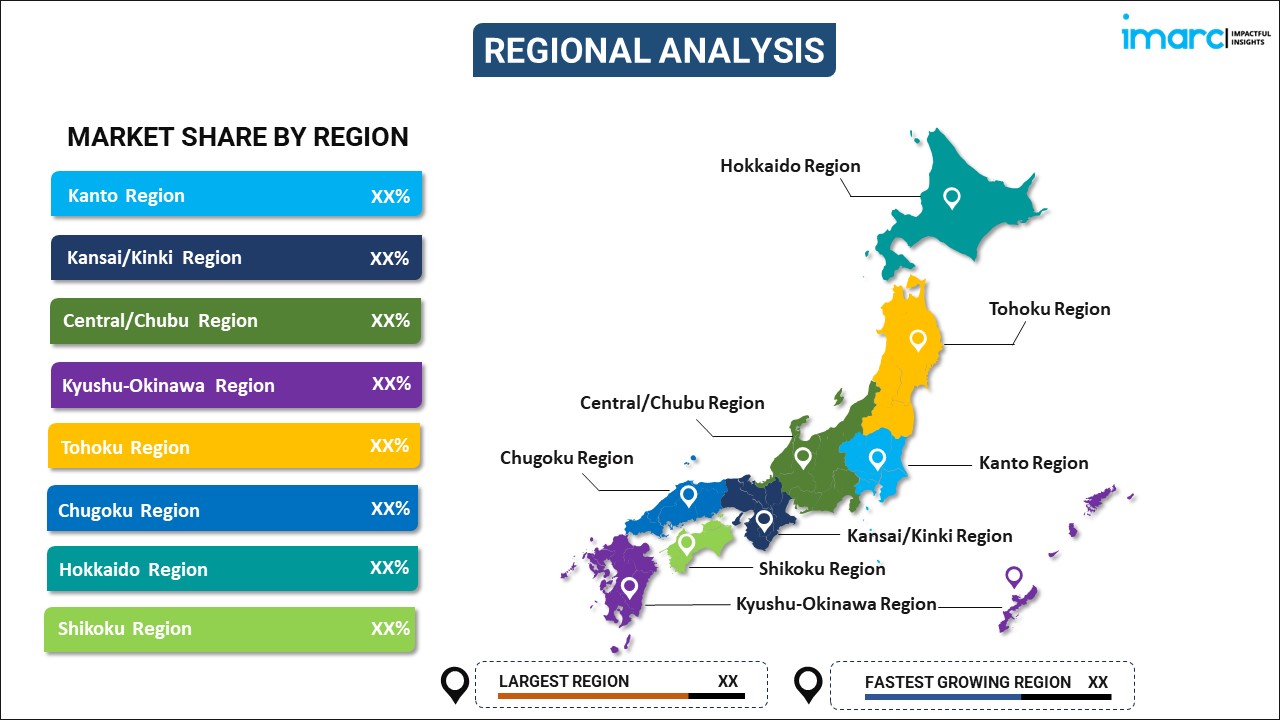
Japan Body Composition Analyzers Market Report by Product (Bioimpedance Analyzer, Skinfold Calipers, Hydrostatic Weighing Equipment, Air Displacement Plethysmography, Dual Energy X-Ray Absorptiometry, and Others), End User (Hospitals, Fitness Clubs and Wellness Centers, Academic and Research Centers, and Others), and Region 2025-2033
Market Overview:
Japan body composition analyzers market size reached USD 30.0 Million in 2024. Looking forward, IMARC Group expects the market to reach USD 53.2 Million by 2033, exhibiting a growth rate (CAGR) of 6.27% during 2025-2033. The increasing emphasis on health and wellness among the Japanese people, rising prevalence of lifestyle-related health issues, such as obesity and diabetes, and the expanding aging population represent some of the key factors driving the market.
|
Report Attribute
|
Key Statistics
|
|---|---|
|
Base Year
|
2024
|
|
Forecast Years
|
2025-2033
|
|
Historical Years
|
2019-2024
|
|
Market Size in 2024
|
USD 30.0 Million |
|
Market Forecast in 2033
|
USD 53.2 Million |
| Market Growth Rate 2025-2033 | 6.27% |
Body composition analyzers are medical devices or tools that measure and quantify the different components of the body composition of a person. They provide a more detailed and accurate assessment of the physical makeup of an individual than traditional measures like body weight alone. They offer high precision in assessing the various components of the body, often providing measurements with a low margin of error. They are non-invasive and do not require surgical procedures or blood tests, making them safe and comfortable for people. They can provide multiple measurements, including body fat percentage, muscle mass, visceral fat, bone density, and hydration levels. They are user-friendly with intuitive interfaces and quick measurement processes. They are commonly used by fitness enthusiasts and athletes to track their progress, set fitness goals, and optimize training and nutrition plans. They assist in weight management by helping individuals understand their body composition changes over time, thus enabling more effective weight loss or muscle gain strategies. They can aid in the early detection of conditions like osteoporosis or obesity-related health issues by assessing bone density and body fat levels.
Japan Body Composition Analyzers Market Trends:
The increasing emphasis on health and wellness among the Japanese population represents one of the primary factors contributing to the market growth. Additionally, the expanding aging population, coupled with the rising concerns over lifestyle-related health issues, such as obesity and diabetes, is driving the demand for tools that provide accurate and comprehensive insights into the body composition of an individual. Along with this, the increasing number of people adopting healthier lifestyles and fitness regimens is strengthening the growth of the market. Furthermore, several gyms, wellness centers, and personal trainers are incorporating body composition analyzers into their programs to offer clients a comprehensive assessment of their progress. Apart from this, several leading manufacturers are continuously improving the precision and user-friendliness of body composition analyzers. The introduction of analyzers with features like Bluetooth connectivity and smartphone apps is making it easier for users to track their progress and share data with healthcare providers or fitness coaches. These technological enhancements are appealing to tech-savvy Japanese people who value data-driven approaches to health and fitness, which, in turn, is contributing to the market growth. Moreover, the rising trend toward preventive healthcare is driving the adoption in clinical settings. Doctors and other healthcare providers are using body composition analyzers to assess the risk factors of patients for various health conditions, guiding early interventions and personalized treatment plans. Besides this, many leading market players are focusing on developing more environment-friendly and energy-efficient body composition analyzers, aligning with the broader sustainability goals of healthcare and fitness industries across the country.
Japan Body Composition Analyzers Market Segmentation:
IMARC Group provides an analysis of the key trends in each segment of the market, along with forecasts at the country level for 2025-2033. Our report has categorized the market based on product and end user.
Product Insights:

- Bioimpedance Analyzer
- Skinfold Calipers
- Hydrostatic Weighing Equipment
- Air Displacement Plethysmography
- Dual Energy X-Ray Absorptiometry
- Others
The report has provided a detailed breakup and analysis of the market based on the product. This includes bioimpedance analyzer, skinfold calipers, hydrostatic weighing equipment, air displacement plethysmography, dual energy x-ray absorptiometry, and others.
End User Insights:
- Hospitals
- Fitness Clubs and Wellness Centers
- Academic and Research Centers
- Others
A detailed breakup and analysis of the market based on the end user have also been provided in the report. This includes hospitals, fitness clubs and wellness centers, academic and research centers, and others.
Regional Insights:

- Kanto Region
- Kansai/Kinki Region
- Central/ Chubu Region
- Kyushu-Okinawa Region
- Tohoku Region
- Chugoku Region
- Hokkaido Region
- Shikoku Region
The report has also provided a comprehensive analysis of all the major regional markets, which include Kanto Region, Kansai/Kinki Region, Central/ Chubu Region, Kyushu-Okinawa Region, Tohoku Region, Chugoku Region, Hokkaido Region, and Shikoku Region.
Competitive Landscape:
The market research report has also provided a comprehensive analysis of the competitive landscape. Competitive analysis such as market structure, key player positioning, top winning strategies, competitive dashboard, and company evaluation quadrant has been covered in the report. Also, detailed profiles of all major companies have been provided.
Japan Body Composition Analyzers Market Report Coverage:
| Report Features | Details |
|---|---|
| Base Year of the Analysis | 2024 |
| Historical Period | 2019-2024 |
| Forecast Period | 2025-2033 |
| Units | Million USD |
| Scope of the Report | Exploration of Historical Trends and Market Outlook, Industry Catalysts and Challenges, Segment-Wise Historical and Future Market Assessment:
|
| Products Covered | Bioimpedance Analyzer, Skinfold Calipers, Hydrostatic Weighing Equipment, Air Displacement Plethysmography, Dual Energy X-Ray Absorptiometry, Others |
| End Users Covered | Hospitals, Fitness Clubs and Wellness Centers, Academic and Research Centers, Others |
| Regions Covered | Kanto Region, Kansai/Kinki Region, Central/ Chubu Region, Kyushu-Okinawa Region, Tohoku Region, Chugoku Region, Hokkaido Region, Shikoku Region |
| Customization Scope | 10% Free Customization |
| Post-Sale Analyst Support | 10-12 Weeks |
| Delivery Format | PDF and Excel through Email (We can also provide the editable version of the report in PPT/Word format on special request) |
Key Questions Answered in This Report:
- How has the Japan body composition analyzers market performed so far and how will it perform in the coming years?
- What has been the impact of COVID-19 on the Japan body composition analyzers market?
- What is the breakup of the Japan body composition analyzers market on the basis of product?
- What is the breakup of the Japan body composition analyzers market on the basis of end user?
- What are the various stages in the value chain of the Japan body composition analyzers market?
- What are the key driving factors and challenges in the Japan body composition analyzers?
- What is the structure of the Japan body composition analyzers market and who are the key players?
- What is the degree of competition in the Japan body composition analyzers market?
Key Benefits for Stakeholders:
- IMARC’s industry report offers a comprehensive quantitative analysis of various market segments, historical and current market trends, market forecasts, and dynamics of the Japan body composition analyzers market from 2019-2033.
- The research report provides the latest information on the market drivers, challenges, and opportunities in the Japan body composition analyzers market.
- Porter's five forces analysis assist stakeholders in assessing the impact of new entrants, competitive rivalry, supplier power, buyer power, and the threat of substitution. It helps stakeholders to analyze the level of competition within the Japan body composition analyzers industry and its attractiveness.
- Competitive landscape allows stakeholders to understand their competitive environment and provides an insight into the current positions of key players in the market.
Need more help?
- Speak to our experienced analysts for insights on the current market scenarios.
- Include additional segments and countries to customize the report as per your requirement.
- Gain an unparalleled competitive advantage in your domain by understanding how to utilize the report and positively impacting your operations and revenue.
- For further assistance, please connect with our analysts.
 Inquire Before Buying
Inquire Before Buying
 Speak to an Analyst
Speak to an Analyst
 Request Brochure
Request Brochure
 Request Customization
Request Customization




.webp)




.webp)












